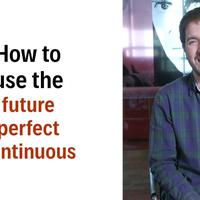How to use the future perfect continuous tense - English In A Minute - YouTube
how|to|use|the|future|perfect|continuous|tense|English||a|Minute|YouTube
|||||perfetto|||||||YouTube
|a|||||continuo|tiempo||en|||YouTube
Kako||||||||||||
Wie verwendet man das Futur Perfekt in der Zeitform - English In A Minute - YouTube
How to use the future perfect continuous tense - English In A Minute - YouTube
Cómo utilizar el futuro perfecto continuo - English In A Minute - YouTube
Comment utiliser le futur parfait continu - English In A Minute - YouTube
Come usare il futuro perfetto continuo - English In A Minute - YouTube
未来完了継続形の使い方 - English In A Minute - YouTube
미래완료형 연속 시제를 사용하는 방법 - 1분 안에 영어 - YouTube
Kaip vartoti būsimąjį būtojo kartinio laiko variantą - English In A Minute - YouTube
Jak używać czasu future perfect continuous - English In A Minute - YouTube
Como usar o tempo verbal futuro perfeito contínuo - Inglês Num Minuto - YouTube
Как использовать будущее совершенное длительное время - English In A Minute - YouTube
Gelecek zaman kipi nasıl kullanılır - English In A Minute - YouTube
How to use the future perfect continuous tense - English In A Minute - YouTube
如何使用将来完成进行时 - 一分钟英语 - YouTube
如何使用将来完成时连续时态 - English In A Minute - YouTube
Hi, I'm Tom and today I'm going to show you
hello||Tom|and||I am||||
||Tom|||||||
Hi, I'm Tom and today I'm going to show you
こんにちは、私はトムです。
Olá, eu sou o Tomás e hoje vou mostrar-vos
Привіт, я Том, і сьогодні я покажу тобі
how to use the future perfect continuous.
كيف||||||
|||the|future||continuous
how to use the future perfect continuous.
未来完了連続体の使い方
como usar o futuro perfeito contínuo.
як вживати майбутній перфект безперервний.
When we use the future perfect continuous,
||||||المستمر
when|we|||future||
|||||mükemmel|
||usamos||||
未来完了継続を使うとき
Коли ми використовуємо майбутнє ідеальне безперервне,
we imagine ourselves at a point in the future
|imagine||||moment||the|
||nós mesmos||||||
|ci immaginiamo|||||||
|уявляємо|себе||||||
||sebe||||||
私たち|想像する|自分たち||||||
未来のある地点にいる自分を想像する
ми уявляємо себе в точці майбутнього
and we then talk about a continuing action
|we||||a|ongoing|
||||||azione continua|azione continua
そして、継続的な行動について話す
і тоді ми говоримо про триваючу дію
which leads to this point.
|приводит|||
|leads|to||
|leva a|||
|ulaşır|||
|porta a|||
|privede|||točki
ということにつながる。
що веде до цієї точки.
Let's practise.
|pratichiamo
|praticar
練習しよう。
Давайте потренуватися.
At the start of the next scene,
||beginning||the|next|
||||||sahne
||||||scena(1)
||||||cena
||||||sceni
次のシーンの始まりに、
На початку наступної сцени,
I will have been eating noodles for five minutes.
|||||makarna|||
I||have||eating||||
|||||نودلز|||
Io|||||vermicelli|||
|||||macarrão|||
5分間、麺を食べ続けていることになる。
Я буду їсти локшину протягом п'яти хвилин.
See?
分かるかい?
Побачити?
It's nearly finished!
|Skoro je završeno!|
it is||
|quasi|
|quase|
ほぼ完成しています!
Майже закінчено!
We make this tense using
we||this||
||||kullanarak
この時制を作るには
Ми робимо це напруженим за допомогою
subject + will have been + (verb)ing.
subject||||verb|
|||||vermekte
soggetto|||||
主語+will have been+(動詞)ing。
özne + will have been + (fiil)ing.
підмет + will have been + (verb)ing.
For example:
for|
例えば、こうだ:
Örnek olarak:
At lunchtime, I will have been working for four hours.
at||||have||working|||
|na hora do almoço||||||||
|öğle yemeği zamanı|ben|will||||için||
|점심 시간||||||||
|l'ora di pranzo||||||||
|la hora del almuerzo||||||||
ランチタイムには4時間働いている。
Öğle yemeğinde, dört saattir çalışıyor olacağım.
В обідній час я буду працювати чотири години.
And we can also use 'won't'
and||are able to|||will not
|||||意志動詞
|||||no
|||||não vamos
そして、「won't」も使える。
Ve 'won't' kullanabiliriz
І ми також можемо використовувати "не буду"
to make the tense negative.
to||the|tense|
で時制を否定にする。
zamanı olumsuz yapmak için.
зробити час негативним.

